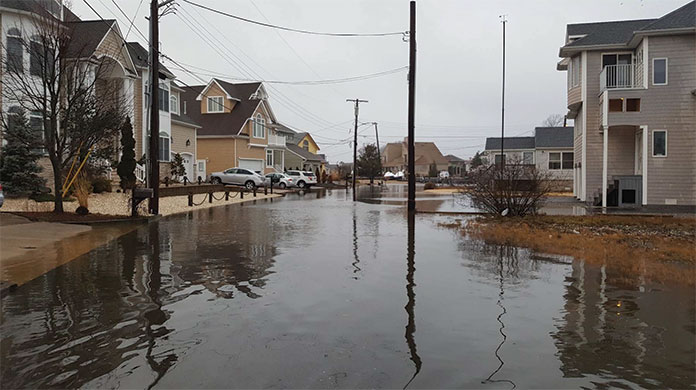
NORMANDY BEACH – Brick and Toms River are joining forces to elevate the roads that traverse both towns in the Normandy Beach section of the barrier island since the neighborhood is split between the two townships.
Flooding has become so bad that school buses and delivery trucks are unable to drive through a main access road there. Residents say roads that used to flood a handful of times a year now flood 20-30 times a year.
The townships applied separately to the New Jersey Department of Transportation (NJDOT) Fiscal Year 2021 Municipal Aid Program for grant funds. Brick was awarded $417,028 and Toms River was awarded $323,600.
According to a statement issued by Brick Township, 549 municipalities submitted for funding from the program and requested more than $342 million.
Brick Township engineer Elissa Commins said that Brick has already collected survey information for the neighborhoods to assess how high the roadway elevations can go. The goal is to raise them approximately 2.5 feet above sea level, she wrote in an email.
“If the elevations of the surrounding private properties will allow us to go higher, we will,” she said. “If not, we will do the best that we can.”

Toms River will be hiring a consulting firm to design the roadway elevation project within the next few months, she said. The timeline associated with the Municipal Aid Grant requires that a contract be awarded within18 months of the notice of award.
The project’s goal is to alleviate flooding issues in the area, with a focus on elevating the road surfaces of Broad Street and portions of 5th, 6th, and 7th Avenues.
The design of the project and the construction estimate was prepared by Toms River’s professionals with assistance from Brick Township. Toms River will be responsible for seeking bids and awarding the contract for the project.
That’s true, said Toms River Township Engineer Bob Chankalian. He said Toms River has experience with road elevations and is working on a fifth project right now.
“They’ve all been very, very successful,” Chankalian said in a phone interview. “Some were on the barrier island and some were on the back bay.”
Toms River has also been successful in getting NJDOT Municipal Aid funds for these kinds of jobs over the years, he added. The municipalities applied for the funds independently to maximize the amount of money each could get, “which, luckily, worked out,” he said.
Chankalian said that roads have catch basins every 400-500 feet, and “we try to pick that low point up,” and sometimes install additional little low points for additional drainage, creating a washboard effect.
The engineer was asked if residential yards flood after the roads are raised, which he said is a common misconception.
“The best analogy for that is, you get in the bathtub and the water rises, but it doesn’t rise if you get in the ocean,” Chankalian said.
He said the way it works is like an island coming out of the sea: “you’re either above sea level or you’re not,” he explained. “If you’re higher than two feet above sea level, generally you’ll be dry,” he said. When the tide rises, the water comes up out of the ground.
Elevating the roads does two things, he said: it reduces the frequency of street flooding, and when it does flood, it decreases the depth of the flooding.
“We raise it as high as we can, but we always make sure that the road is still a little bit lower than peoples’ garages and things like that,” Chankalian said.
Brick engineer Commins said the lowest centerline elevation in the Brick section of Normandy Beach is 1.16 feet with a gutter elevation of approximately 0.7 feet above sea level.
Normandy Beach resident Larry Reid said that while it’s wonderful that Brick and Toms River are working together and got some grant money to fix the problem, the scope of the project falls short for Brick residents.
“There’s about 150 people that have to drive through the flooded streets, and the grants will fix the roads for about 37 of them,” said Reid in a recent phone call.
There would be 113 of the Brick residents who would still have to drive through flooded waters on Broad Avenue to where the project stops – north of 7th Avenue.
Reid said that he and his grandson were trying to get home during a recent high tide, but he couldn’t drive through the flooded road.

“I called to get a ride from the police department, as they had told us to do, and we had to wait an hour and a half for the police and their hummer to come and pick us up,” he said.
Commins said that Brick and Toms River partnered in the grant applications only for the areas in Normandy Beach where the two municipalities overlap.
She said Brick is seeking additional funding through the FEMA Building Resilient Infrastructure and Communities Program to elevate the remainder of the bay side of Normandy Beach, as well as Shore Acres and the road that leads into Seawood Harbor.
“This program is new, and therefore, lacks a track record of approved applications to use as a guide,” Commins said.
“It should be noted that elevating all the roads in Normandy Beach in one year would consume all of the capital allocated for roadways for at least one, possible two years,” she said. “Short of getting additional funding through grants, the elevation of the neighborhood’s roads must be phased.”






